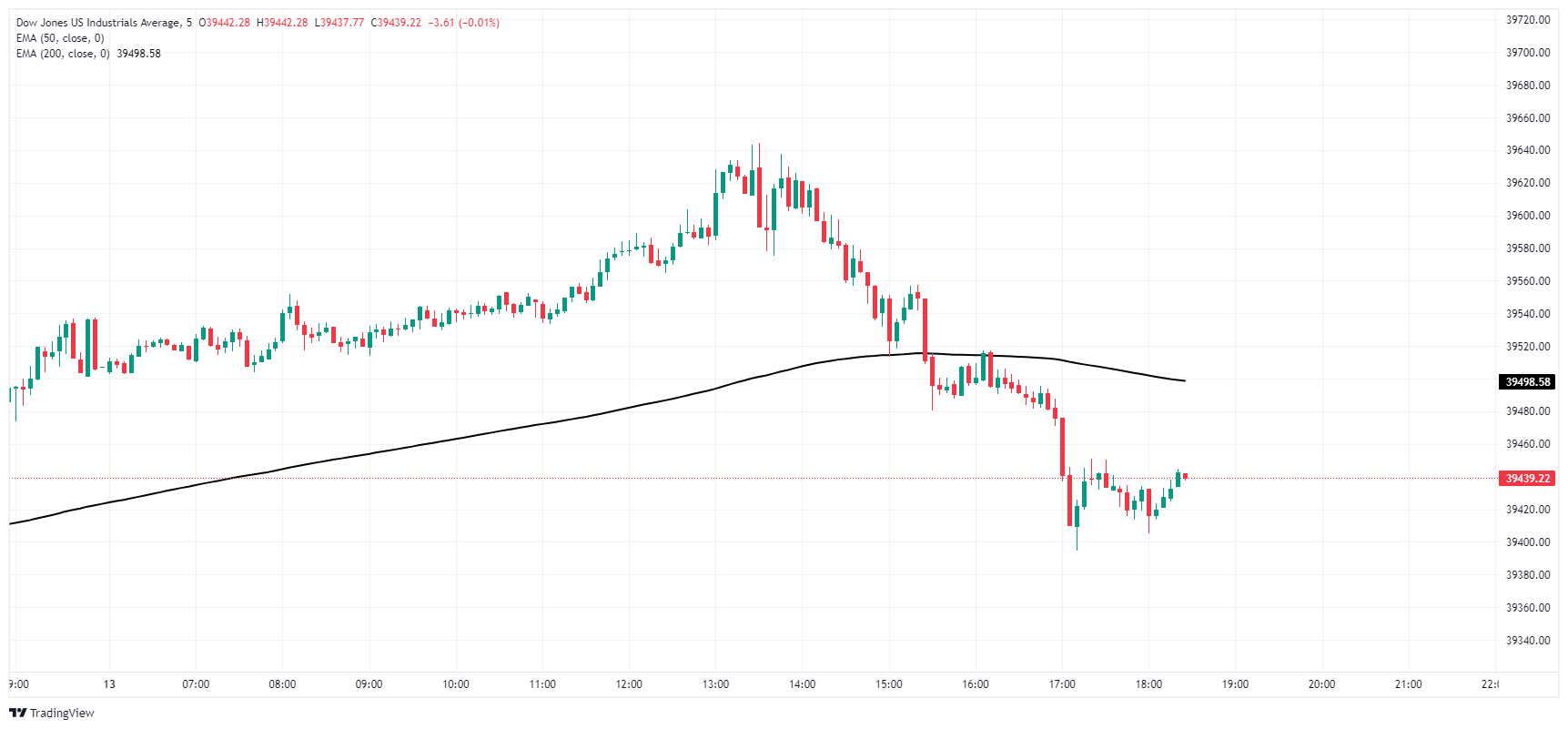- Analytics
- News and Tools
- Market News
- Dow Jones Industrial Average stumbles after consumer inflation outlook rises
Dow Jones Industrial Average stumbles after consumer inflation outlook rises
- Dow Jones sheds 0.2% on Monday after NY Fed inflation survey accelerated.
- Markets continue to pin hopes on Fed rate cuts in 2024.
- US PPI, CPI inflation figures loom in the week ahead.
The Dow Jones Industrial Average (DJIA) kicked off the new trading week softly higher before getting knocked back after the Federal Reserve (Fed) Bank of New York revealed that consumer inflation expectations for the coming year accelerated to 3.3%. NY Fed consumer one-year inflation expectations from the previous 3.0% as price growth continues to eat away at consumer purchasing power.
US Producer Price Index (PPI) inflation data is slated for Tuesday. Markets expect Core PPI Inflation for the year ended April to hold steady at 2.4%. On Wednesday, US Consumer Price Index (CPI) inflation data will be updated, with April’s MoM headline CPI inflation expected to hold flat at 0.4%.
Despite rising consumer inflation expectations, market participants continue to lean into Fed rate cut hopes. According to the CME’s FedWatch Tool, rate markets are pricing in 65% odds of a September rate trim, with 90% odds priced in of at least one rate cut in before the end of the year. Market bets on rate cuts have begun to come unchained from overall expectations, with a Reuters poll of economists revealing nearly two-thirds of respondents expecting a September cut. At the same time, polled economists also do not see inflation hitting the Fed’s 2% target until 2026, complicating the outlook for Fed rate cuts.
Dow Jones news
The Dow Jones is down around a fifth of a percent on Monday, with half of the index’s component equities in the red for the day’s market session. Home Depot Inc. (HD) is leading the index lower, tumbling -1.4% and losing around 5 points to trade at $351.52 per share. On the high side, Intel Corp. (INTC) rose around 2.7%, climbing to $30.64 per share.
Dow Jones technical outlook
The Dow Jones Industrial Average rose to 39,640.00 early Monday before an intraday slide, bouncing off of the 39,400.00 level as the major equity index churns within technical levels established late last week.
Daily candlesticks show the Dow Jones index is due for a pullback with the index still trading on the high end of a seven-day winning streak, having risen around 5% from the last swing low into 37,600.00. The Dow Jones’ recent bull run brought the equity index within reach of all-time highs set just below the 40,000.00 price level, and bulls remain firmly in control with price action firmly norther of the 200-day Exponential Moving Average (EMA) at 36,938.27.
Dow Jones five minute chart
Dow Jones daily chart
Fed FAQs
Monetary policy in the US is shaped by the Federal Reserve (Fed). The Fed has two mandates: to achieve price stability and foster full employment. Its primary tool to achieve these goals is by adjusting interest rates. When prices are rising too quickly and inflation is above the Fed’s 2% target, it raises interest rates, increasing borrowing costs throughout the economy. This results in a stronger US Dollar (USD) as it makes the US a more attractive place for international investors to park their money. When inflation falls below 2% or the Unemployment Rate is too high, the Fed may lower interest rates to encourage borrowing, which weighs on the Greenback.
The Federal Reserve (Fed) holds eight policy meetings a year, where the Federal Open Market Committee (FOMC) assesses economic conditions and makes monetary policy decisions. The FOMC is attended by twelve Fed officials – the seven members of the Board of Governors, the president of the Federal Reserve Bank of New York, and four of the remaining eleven regional Reserve Bank presidents, who serve one-year terms on a rotating basis.
In extreme situations, the Federal Reserve may resort to a policy named Quantitative Easing (QE). QE is the process by which the Fed substantially increases the flow of credit in a stuck financial system. It is a non-standard policy measure used during crises or when inflation is extremely low. It was the Fed’s weapon of choice during the Great Financial Crisis in 2008. It involves the Fed printing more Dollars and using them to buy high grade bonds from financial institutions. QE usually weakens the US Dollar.
Quantitative tightening (QT) is the reverse process of QE, whereby the Federal Reserve stops buying bonds from financial institutions and does not reinvest the principal from the bonds it holds maturing, to purchase new bonds. It is usually positive for the value of the US Dollar.
© 2000-2024. All rights reserved.
This site is managed by Teletrade D.J. LLC 2351 LLC 2022 (Euro House, Richmond Hill Road, Kingstown, VC0100, St. Vincent and the Grenadines).
The information on this website is for informational purposes only and does not constitute any investment advice.
The company does not serve or provide services to customers who are residents of the US, Canada, Iran, The Democratic People's Republic of Korea, Yemen and FATF blacklisted countries.
Making transactions on financial markets with marginal financial instruments opens up wide possibilities and allows investors who are willing to take risks to earn high profits, carrying a potentially high risk of losses at the same time. Therefore you should responsibly approach the issue of choosing the appropriate investment strategy, taking the available resources into account, before starting trading.
Use of the information: full or partial use of materials from this website must always be referenced to TeleTrade as the source of information. Use of the materials on the Internet must be accompanied by a hyperlink to teletrade.org. Automatic import of materials and information from this website is prohibited.
Please contact our PR department if you have any questions or need assistance at pr@teletrade.global.















